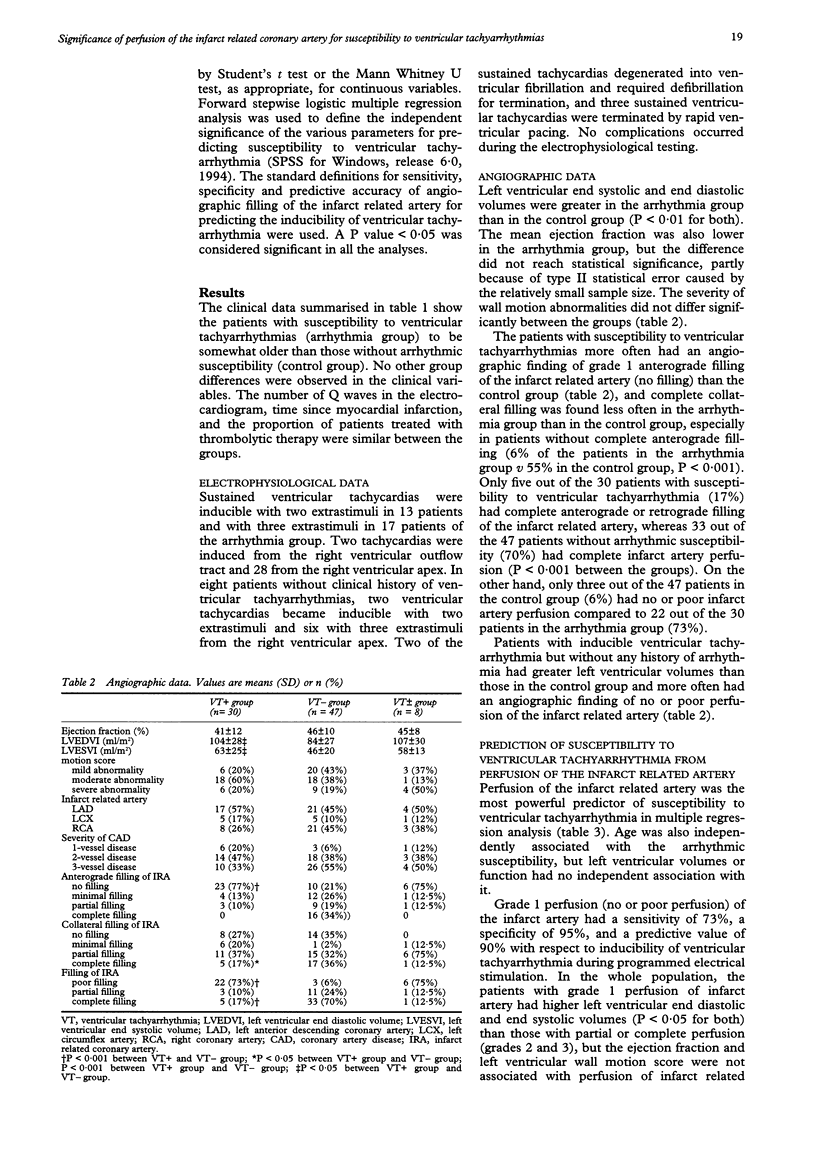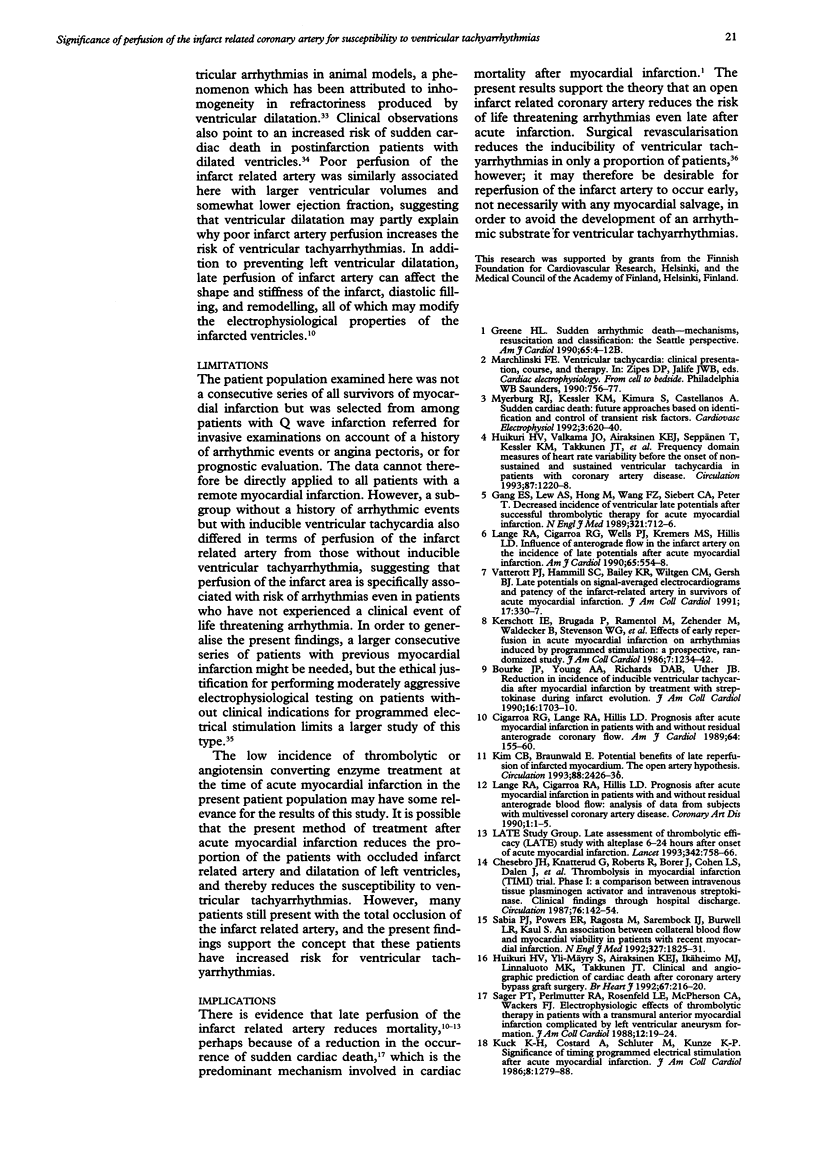Abstract
OBJECTIVE--To study the significance of perfusion of the infarct related coronary artery for susceptibility to ventricular tachyarrhythmias in patients with a remote myocardial infarction. SETTING--Tertiary referral cardiac centre. METHODS--Angiographic filling of the infarct related artery was assessed in a consecutive series of 85 patients with different susceptibilities to ventricular tachyarrhythmias after previous (> 3 months) Q wave myocardial infarction: 30 patients had a history of cardiac arrest (n = 16) or sustained ventricular tachycardia (n = 14), and sustained ventricular tachyarrhythmia was inducible in these by programmed electrical stimulation (arrhythmia group); 47 patients had no clinical arrhythmic events and no inducible ventricular tachyarrhythmias during programmed ventricular stimulation (control group). Eight patients without a history of any arrhythmic events were inducible into ventricular tachycardia. RESULTS--The patients in the arrhythmia group were older (63 (SD 8) years) than the control patients (59 (6) years, P < 0.05), and had larger left ventricular volumes in cineangiography (P < 0.01), but ejection fraction, severity of left ventricular wall motion abnormalities, previous thrombolytic therapy, and time from previous infarction did not differ between the groups. Patients with susceptibility to ventricular tachyarrhythmias more often had a totally occluded infarct related artery on angiography (77%) than patients without arrhythmia susceptibility (21%) (P < 0.001), and complete collateral filling of the infarct artery in cases without complete anterograde filling was less common in the arrhythmia group than in the control group (P < 0.001). Patients without a history of malignant arrhythmia but with inducible ventricular tachyarrhythmia also had no or poor perfusion of the infarct artery more often than the patients without inducible arrhythmia (P < 0.001). Logistic multiple regression showed that no or poor anterograde or collateral filling of the infarct related artery was the most powerful predictor of susceptibility to ventricular tachyarrhythmias (P < 0.001). Left ventricular size and function were not independently related to arrhythmic susceptibility. CONCLUSIONS--No or poor angiographic filling of the infarct related artery is closely associated with susceptibility to ventricular tachyarrhythmias late after acute myocardial infarction, suggesting that perfusion of the infarct artery will modify favourably the electrophysiological substrate of the infarct scar independently of the myocardial salvage achieved by early reperfusion.
Full text
PDF





Selected References
These references are in PubMed. This may not be the complete list of references from this article.
- Bourke J. P., Young A. A., Richards D. A., Uther J. B. Reduction in incidence of inducible ventricular tachycardia after myocardial infarction by treatment with streptokinase during infarct evolution. J Am Coll Cardiol. 1990 Dec;16(7):1703–1710. doi: 10.1016/0735-1097(90)90323-h. [DOI] [PubMed] [Google Scholar]
- Brown E. J., Jr, Swinford R. D., Gadde P., Lillis O. Acute effects of delayed reperfusion on myocardial infarct shape and left ventricular volume: a potential mechanism of additional benefits from thrombolytic therapy. J Am Coll Cardiol. 1991 Jun;17(7):1641–1650. doi: 10.1016/0735-1097(91)90660-2. [DOI] [PubMed] [Google Scholar]
- Calkins H., Maughan W. L., Weisman H. F., Sugiura S., Sagawa K., Levine J. H. Effect of acute volume load on refractoriness and arrhythmia development in isolated, chronically infarcted canine hearts. Circulation. 1989 Mar;79(3):687–697. doi: 10.1161/01.cir.79.3.687. [DOI] [PubMed] [Google Scholar]
- Charney R., Cohen M. The role of the coronary collateral circulation in limiting myocardial ischemia and infarct size. Am Heart J. 1993 Oct;126(4):937–945. doi: 10.1016/0002-8703(93)90710-q. [DOI] [PubMed] [Google Scholar]
- Chesebro J. H., Knatterud G., Roberts R., Borer J., Cohen L. S., Dalen J., Dodge H. T., Francis C. K., Hillis D., Ludbrook P. Thrombolysis in Myocardial Infarction (TIMI) Trial, Phase I: A comparison between intravenous tissue plasminogen activator and intravenous streptokinase. Clinical findings through hospital discharge. Circulation. 1987 Jul;76(1):142–154. doi: 10.1161/01.cir.76.1.142. [DOI] [PubMed] [Google Scholar]
- Cigarroa R. G., Lange R. A., Hillis L. D. Prognosis after acute myocardial infarction in patients with and without residual anterograde coronary blood flow. Am J Cardiol. 1989 Jul 15;64(3):155–160. doi: 10.1016/0002-9149(89)90449-9. [DOI] [PubMed] [Google Scholar]
- Farrell T. G., Bashir Y., Cripps T., Malik M., Poloniecki J., Bennett E. D., Ward D. E., Camm A. J. Risk stratification for arrhythmic events in postinfarction patients based on heart rate variability, ambulatory electrocardiographic variables and the signal-averaged electrocardiogram. J Am Coll Cardiol. 1991 Sep;18(3):687–697. doi: 10.1016/0735-1097(91)90791-7. [DOI] [PubMed] [Google Scholar]
- Freedman R. A., Swerdlow C. D., Soderholm-Difatte V., Mason J. W. Clinical predictors of arrhythmia inducibility in survivors of cardiac arrest: importance of gender and prior myocardial infarction. J Am Coll Cardiol. 1988 Oct;12(4):973–978. doi: 10.1016/0735-1097(88)90463-9. [DOI] [PubMed] [Google Scholar]
- Gang E. S., Lew A. S., Hong M., Wang F. Z., Siebert C. A., Peter T. Decreased incidence of ventricular late potentials after successful thrombolytic therapy for acute myocardial infarction. N Engl J Med. 1989 Sep 14;321(11):712–716. doi: 10.1056/NEJM198909143211104. [DOI] [PubMed] [Google Scholar]
- Huikuri H. V., Valkama J. O., Airaksinen K. E., Seppänen T., Kessler K. M., Takkunen J. T., Myerburg R. J. Frequency domain measures of heart rate variability before the onset of nonsustained and sustained ventricular tachycardia in patients with coronary artery disease. Circulation. 1993 Apr;87(4):1220–1228. doi: 10.1161/01.cir.87.4.1220. [DOI] [PubMed] [Google Scholar]
- Huikuri H. V., Yli-Mäyry S., Airaksinen K. E., Ikäheimo M. J., Linnaluoto M. K., Takkunen J. T. Clinical and angiographic prediction of cardiac death after coronary artery bypass graft surgery. Br Heart J. 1992 Mar;67(3):216–220. doi: 10.1136/hrt.67.3.216. [DOI] [PMC free article] [PubMed] [Google Scholar]
- Hunt G. B., Ross D. L. Influence of infarct age on reproducibility of ventricular tachycardia induction in a canine model. J Am Coll Cardiol. 1989 Sep;14(3):765–776. doi: 10.1016/0735-1097(89)90123-x. [DOI] [PubMed] [Google Scholar]
- Jeremy R. W., Hackworthy R. A., Bautovich G., Hutton B. F., Harris P. J. Infarct artery perfusion and changes in left ventricular volume in the month after acute myocardial infarction. J Am Coll Cardiol. 1987 May;9(5):989–995. doi: 10.1016/s0735-1097(87)80298-x. [DOI] [PubMed] [Google Scholar]
- Kelly P., Ruskin J. N., Vlahakes G. J., Buckley M. J., Jr, Freeman C. S., Garan H. Surgical coronary revascularization in survivors of prehospital cardiac arrest: its effect on inducible ventricular arrhythmias and long-term survival. J Am Coll Cardiol. 1990 Feb;15(2):267–273. doi: 10.1016/s0735-1097(10)80046-4. [DOI] [PubMed] [Google Scholar]
- Kersschot I. E., Brugada P., Ramentol M., Zehender M., Waldecker B., Stevenson W. G., Geibel A., De Zwaan C., Wellens H. J. Effects of early reperfusion in acute myocardial infarction on arrhythmias induced by programmed stimulation: a prospective, randomized study. J Am Coll Cardiol. 1986 Jun;7(6):1234–1242. doi: 10.1016/s0735-1097(86)80141-3. [DOI] [PubMed] [Google Scholar]
- Kim C. B., Braunwald E. Potential benefits of late reperfusion of infarcted myocardium. The open artery hypothesis. Circulation. 1993 Nov;88(5 Pt 1):2426–2436. doi: 10.1161/01.cir.88.5.2426. [DOI] [PubMed] [Google Scholar]
- Klein H., Karp R. B., Kouchoukos N. T., Zorn G. L., Jr, James T. N., Waldo A. L. Intraoperative electrophysiologic mapping of the ventricles during sinus rhythm in patients with a previous myocardial infarction. Identification of the electrophysiologic substrate of ventricular arrhythmias. Circulation. 1982 Oct;66(4):847–853. doi: 10.1161/01.cir.66.4.847. [DOI] [PubMed] [Google Scholar]
- Kuck K. H., Costard A., Schlüter M., Kunze K. P. Significance of timing programmed electrical stimulation after acute myocardial infarction. J Am Coll Cardiol. 1986 Dec;8(6):1279–1288. doi: 10.1016/s0735-1097(86)80298-4. [DOI] [PubMed] [Google Scholar]
- Lange R. A., Cigarroa R. G., Wells P. J., Kremers M. S., Hills L. D. Influence of anterograde flow in the infarct artery on the incidence of late potentials after acute myocardial infarction. Am J Cardiol. 1990 Mar 1;65(9):554–558. doi: 10.1016/0002-9149(90)91030-a. [DOI] [PubMed] [Google Scholar]
- Nidorf S. M., Siu S. C., Galambos G., Weyman A. E., Picard M. H. Benefit of late coronary reperfusion on ventricular morphology and function after myocardial infarction. J Am Coll Cardiol. 1993 Mar 1;21(3):683–691. doi: 10.1016/0735-1097(93)90101-6. [DOI] [PubMed] [Google Scholar]
- Pedretti R., Etro M. D., Laporta A., Sarzi Braga S., Carù B. Prediction of late arrhythmic events after acute myocardial infarction from combined use of noninvasive prognostic variables and inducibility of sustained monomorphic ventricular tachycardia. Am J Cardiol. 1993 May 15;71(13):1131–1141. doi: 10.1016/0002-9149(93)90635-p. [DOI] [PubMed] [Google Scholar]
- Sabia P. J., Powers E. R., Ragosta M., Sarembock I. J., Burwell L. R., Kaul S. An association between collateral blood flow and myocardial viability in patients with recent myocardial infarction. N Engl J Med. 1992 Dec 24;327(26):1825–1831. doi: 10.1056/NEJM199212243272601. [DOI] [PubMed] [Google Scholar]
- Sager P. T., Perlmutter R. A., Rosenfeld L. E., McPherson C. A., Wackers F. J., Batsford W. P. Electrophysiologic effects of thrombolytic therapy in patients with a transmural anterior myocardial infarction complicated by left ventricular aneurysm formation. J Am Coll Cardiol. 1988 Jul;12(1):19–24. doi: 10.1016/0735-1097(88)90350-6. [DOI] [PubMed] [Google Scholar]
- Simonson J. S., Gang E. S., Diamond G. A., Vaughn C. A., Mandel W. J., Peter T. Selection of patients for programmed ventricular stimulation: a clinical decision-making model based on multivariate analysis of clinical variables. J Am Coll Cardiol. 1992 Aug;20(2):317–327. doi: 10.1016/0735-1097(92)90097-7. [DOI] [PubMed] [Google Scholar]
- Spear J. F., Horowitz L. N., Hodess A. B., MacVaugh H., 3rd, Moore E. N. Cellular electrophysiology of human myocardial infarction. 1. Abnormalities of cellular activation. Circulation. 1979 Feb;59(2):247–256. doi: 10.1161/01.cir.59.2.247. [DOI] [PubMed] [Google Scholar]
- Vatterott P. J., Hammill S. C., Bailey K. R., Wiltgen C. M., Gersh B. J. Late potentials on signal-averaged electrocardiograms and patency of the infarct-related artery in survivors of acute myocardial infarction. J Am Coll Cardiol. 1991 Feb;17(2):330–337. doi: 10.1016/s0735-1097(10)80095-6. [DOI] [PubMed] [Google Scholar]
- White H. D., Norris R. M., Brown M. A., Brandt P. W., Whitlock R. M., Wild C. J. Left ventricular end-systolic volume as the major determinant of survival after recovery from myocardial infarction. Circulation. 1987 Jul;76(1):44–51. doi: 10.1161/01.cir.76.1.44. [DOI] [PubMed] [Google Scholar]
- el-Sherif N., Ursell S. N., Bekheit S., Fontaine J., Turitto G., Henkin R., Caref E. B. Prognostic significance of the signal-averaged ECG depends on the time of recording in the postinfarction period. Am Heart J. 1989 Aug;118(2):256–264. doi: 10.1016/0002-8703(89)90183-x. [DOI] [PubMed] [Google Scholar]


